Daniel Kornrumpf is an award winning figurative textile artist based in the United States. His depictions of urban life have a visceral, tactile appeal, confronting the viewer head on. He is Adjunct Professor at Emmanuel College and Mount Ida College and is represented by Blank Space Gallery in New York
In this interview Daniel talks about his artistic journey so far, the processes and techniques he employs to produce his unique art, and reveals how coincidence played its part in a particular favourite piece.
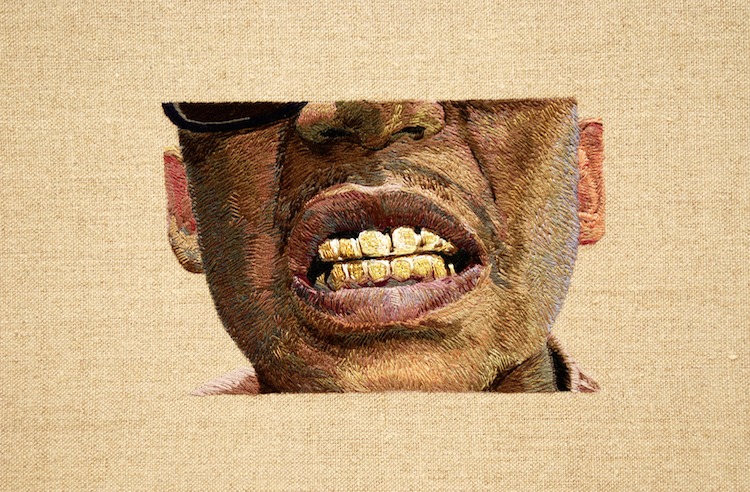
A visceral sensation
TextileArtist.org: What initially attracted you to textiles as a medium?
Daniel Kornrumpf: The overwhelming desire to touch textiles has been my primary attraction to the medium. There is a visceral sensation that I get from merely looking at quilts, or hooked rugs, or tapestries. I can appreciate the way they look and the process in which they were created but the seductive texture of the medium compels me to want to feel it, which is very different from the way I experience a painting.
And, more specifically, how was your imagination captured by embroidery?
Embroideries create a particular level of intimacy, bringing me in close, due to the small scale of the threads, again, making me want to feel the surface. At the Museum of Fine Arts in Boston, I became enamoured by the wonky, hand embroidered cloth globes that 19th century students would make to learn geography. Embroidery, for me, is a way to create imagery using the language of painting but also evoke that strong haptic desire for touch.
What or who were your early influences and how has your life/upbringing influenced your work?
I grew up in the suburbs of Philadelphia where there is a rich tradition of arts and crafts. My dad was a photographer and my mom was a crafter who made quilts, embroideries, stained glass windows, and designs using dried, pressed flowers. They saw my strong interest in drawing and put me in private art lessons at a young age. Growing up in a house, just after the Arts and Crafts revival of the 1970’s, I was surrounded by handmade objects which definitely had a strong impact on my politics and aesthetic. One of my biggest art heroes is the figurative painter, Alice Neel. I first saw a retrospective of her work when I was fourteen at the Philadelphia Museum of Art and it has stayed with me to this day. The energy and life in her paintings is something I strive for in my own work.
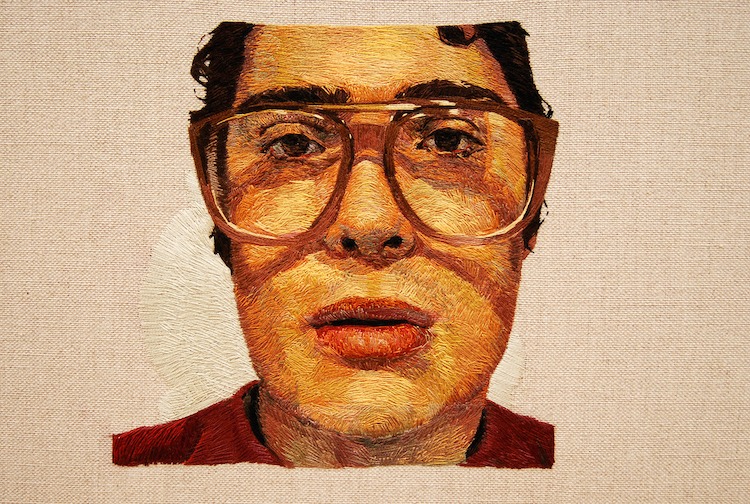
A clown on a unicycle
What was your route to becoming an artist?
My route to becoming an artist is one that seemed destined from the beginning. Its an odd story to start with but I remember drawing a picture of a clown on a unicycle when I was 4 or 5 years old and my mom was so impressed that she signed me up for art lessons at a local day camp. I took private lessons all through grade school and high school and went on to study Fine Arts at Kutztown University in Pennsylvania. The school had a three tremendous programs, one for Fine Arts, one for Crafts, and one for Graphic Design.
I majored in painting but was heavily influenced by the electives I took in the Crafts Department. The school itself is located in rural Pennsylvania, surrounded by farm land and a large Amish and Mennonite population. I remember going to flea markets and seeing the intricate, Pennsylvania Dutch inspired quilts for sale along with hand made furniture. I was in my final year at Kutztown and felt like I had just started to figure out the kind of art that I wanted to create. Not wanting do loose that momentum after graduating, and without taking any time off in between, I went to the Pennsylvania Academy of the Fine Arts in Philadelphia for my graduate studies, focusing again, in painting.
While at PAFA, I began experimenting with other mediums, including embroidery thread. PAFA is where I made my first embroidered portraits. After graduating, I moved to Boston, Massachusetts for a teaching position where I continue to instruct Art Foundation and Design courses. My current body of work still relates to those early portraits from graduate school.
Do you use a sketchbook? If not, what preparatory work do you do?
I have an inconsistent sketchbook practice where I will work out composition ideas and figure out the appropriate spacing between elements for paintings. For my embroideries, however, I don’t sketch but instead, keep folders upon folders of meticulously categorized photographs on my computer. Some are found online, others are my own, but it’s the process of searching through my saved photos and making connections between images that spark ideas for new embroideries.
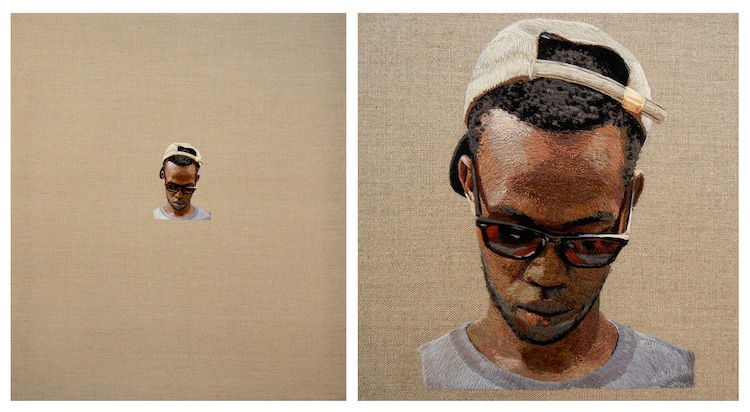
Tell us about your process from conception to conclusion.
The concept for the series of embroideries started in 2006 as a side project in between paintings. After spending way too much time on my computer, clicking through countless profiles from different people on social networking sites, I found myself saving to my computer, the photographs of people that had some interesting quality. A lot of what guided me were these feelings of desire, vanity, and arbitration which play dominant roles in how we choose to represent ourselves to others online. I started going through those saved photos and started drawing them from the computer screen with coloured pencils on mylar.
After a hand full of drawings, I wanted a better relationship between the photographic image, the material used to represent that image, and to reveal the context from where the image had derived. The move to the embroidery thread was to bridge those ideas. I started to experiment with embroidery thread as a drawing replacement to the colored pencils. The thread on canvas was best suited because they are the same material. The thread that makes up the weave of the canvas is the same as the thread that makes up the portrait that’s woven into that canvas. That person on the computer is completely embedded and woven into the social fabric where everyone is connected and the same. At the same time, however, we spend most of our time on the computer alone, which is reason for the way in which the image is composed on the canvas.
I wanted to create a context for where the image came from, the cropped edges referencing photography, the hovering portrait resembling an icon, with empty space around them. It also reminds me of a quote by Rudolf Arnheim where he states in his book, [easyazon_link identifier=”0520261267″ locale=”UK” tag=”wwwtextileart-21″]The Power of the Center , “Perceptually a person is a viewer, who sees himself at the center of the world surrounding him. As he moves, the center of the world stays with him.”
I want the embroideries to simultaneously exist in both of those states of mind; one where we are isolated, detached and self consciously representing ourselves through photographs. The other is, on closer examination, completely embedded and woven into the social fabric where everyone is connected and the same.
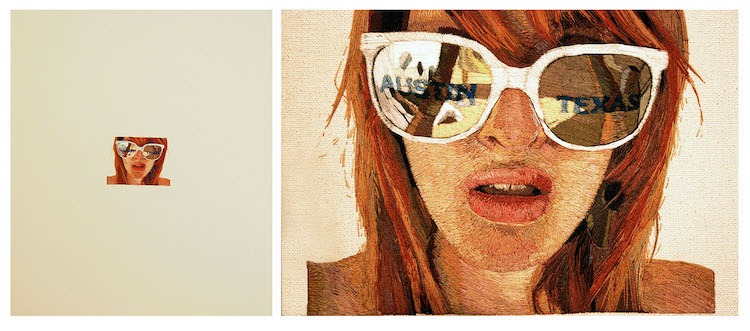
Brightest light possible
Tell us a bit about your chosen techniques.
Once I’ve chosen and edited the photograph that I’m going to use, I print it on transfer paper and iron the image on to the canvas and use the image as a “map” to embroider over. I treat the embroidery thread as if it was a line drawn from a pencil, directing the position, angle, and length of the stitch to relate to the contour of the portrait.
I first embroider blocks of solid colors in certain areas of the face. Once it’s completely covered with the first layer of thread it looks like a paint-by-number painting. Then I go in with different analogous or complimentary colors and start stitching over areas to give the face a more realistic skin tone and 3-dimensional illusion. I treat the image like a drawing, considering the color of the line and the direction of the line to best illustrate the planes and contours of the face.
What environment do you like to work in?
When I’m embroidering, I like to work during the day, close to a window for the brightest light possible. It’s important to see the subtle differences in hue, value, and saturation within my selection of threads. Embroidering is the type of work that, if you have a project underway, you can pick it up anytime, even if you only have an hour in-between obligations. I embroidery while listening to podcasts or catching up on episodes from whatever television series I’m watching. It’s the type of work that doesn’t require your full attention, unlike painting.
What currently inspires you?
Recently, I’ve been inspired by the art direction in movies from Hollywood’s golden era. Film director’s and choreographers like Charles Walters or Michael Curtiz from the 1940’s to the 60’s have composed some of the most visually stimulating arrangements of colors, objects, and figures. My work has revolved around “the center” for so long that I’ve wanted to study more dynamic compositions and those films are the best to learn from. I also find a lot if inspiration from shopping at thrift stores. Fabric patterns from decades past and unique or strange household objects help spark ideas for forms or color combinations for my paintings and embroideries.
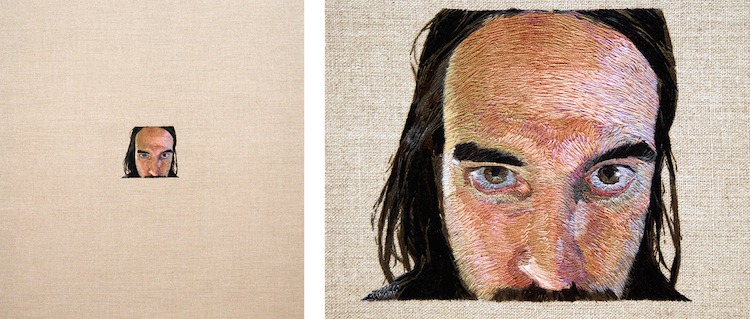
Life and empathy
Who have been your major influences and why?
My biggest influences have been the figurative painters that made work in an era when figurative painting was looked down upon due to the dominance of abstract expressionism. Like Philip Pearlstein, with his cold figures but methodically arranged compositions, and Alice Neel’s figures, the opposite to Pearlstein’s, giving her subjects life and empathy, and drawn in her quirky, distorted, but enchanting style. Or Ben Shaun with his large hands and ability to tell a story with pictures, and Fairfield Porter with his inviting, uplifting color palette. They all depict the figure, but their paintings are less about the figures as individuals and more about the artist’s priorities, showcasing their idiosyncratic way of painting.
Tell us about a piece of your work that holds particularly fond memories and why?
I really love the portrait of Brooklyn Bobby. His expression, combined with the technical execution of the line work and color relationships does something that keeps me looking. The one of Brooklyn Bobby is also my favorite because the story behind it is so ridiculous that most people don’t think that it’s true. I found Brooklyn Bobby’s image the way I found all of the people I draw and embroider, randomly navigating online profiles. It was in 2006, in the days of Myspace when you could easily search through other people’s profile pictures. I remember clicking around, going from person to person and stopping on him and thinking that he had such an interesting face.
So I spent two months, day after day, creating that embroidered portrait of him. This was in graduate school so I had critics coming in and out critiquing my work. This one critic came in and the first thing he said was, “Oh, you know Bobby?” This first coincidence shocked me. Here’s this image of a guy I know nothing about and this art critic that’s with me knows him, making Bobby a real person all of a sudden.
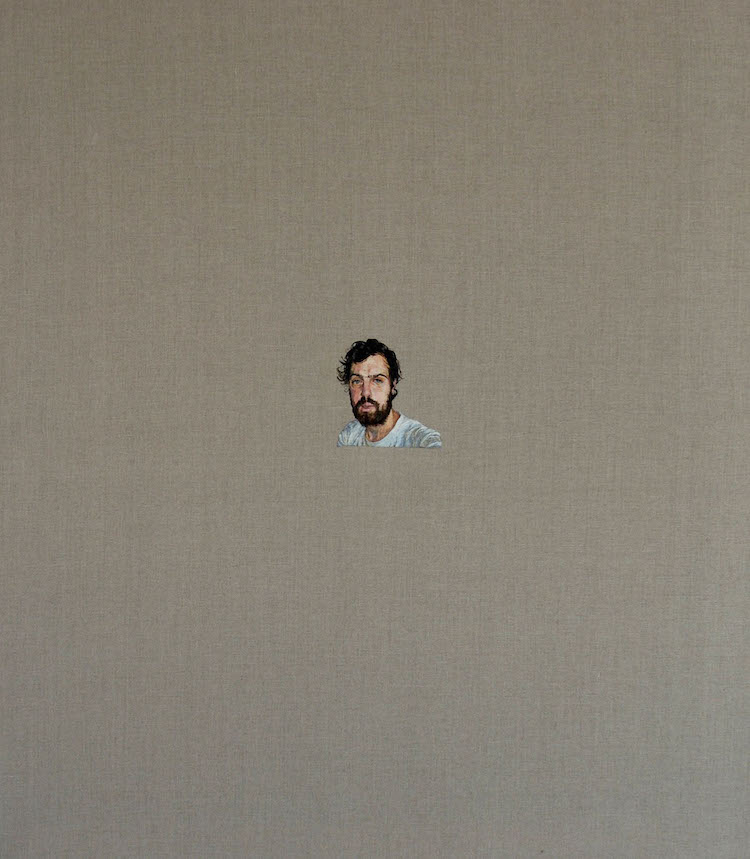
It turned out that Bobby and the critic used to skateboard together in Philadelphia, even though Bobby lived in New York. So then I go back to Bobby’s profile and saw that the last person to leave him a comment was this girl Alicia. I went to her profile and saw that she was 24 years old and from Cape Cod. This was the second odd coincidence because my girlfriend was 24 from Cape Cod. I asked her if she knew this girl that knows Bobby and she says, “Yeah, we went to elementary school together!” I look again and Alicia turns out to be Bobby’s girlfriend too so now our girlfriends went to elementary school together! So after those two strange coincidences I was pretty amazed, seeing as I had found him from aimless internet surfing.
Then, four days later, as I was walking to my studio in Philadelphia, no other than Bobby himself was standing outside of a Deli waiting for a sandwich. Right then, in my mind I was thinking how strange it would be if I randomly went up to him and said, “Hey you don’t know me but I just spent two months embroidering your portrait and it’s in my studio right across the street if you want to see it”. Instead, I just stared at him in amazement, not believing it was really him and couldn’t say anything. He went in and got his sandwich and I went to my studio. I later sent him a message online asking if that was in fact him, which it was, and sent him images of the embroidery which he really enjoyed. But I will, for the rest of my life, forever regret not talking to him in person when I had the chance.
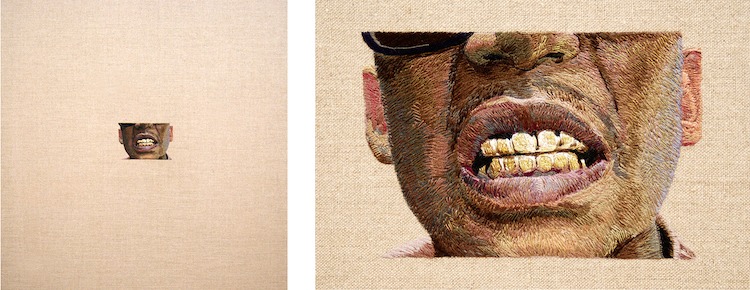
What advice would you give to an aspiring textile artist?
Keep creating. What I find to be the hardest part, is starting. This advice may be really specific but there is a tendency to put a lot of time and effort in to one piece and once that piece is complete, it’s tempting to stop creating new things for awhile.
Keep the momentum by starting a new one, or better yet, have two or three different ones that are at different stages. You can pick and choose which one you are more interested in working on any given day. Satisfaction tends to come from seeing the completed result but with textiles, it can be weeks, if not months, before finishing a piece. Its nice to have smaller, quicker projects underway as well so that feeling of satisfaction comes more often and fuels you for the more time-intensive, laboured projects.
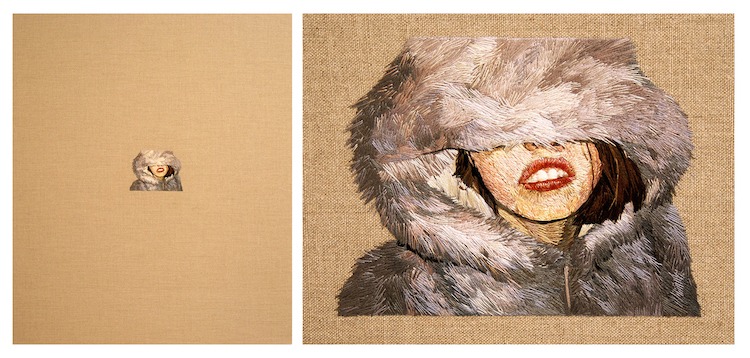
What other resources do you use? Blogs, websites, magazines etc.
I like to follow specific textile artists or designers on Instagram. Some of my favorites on Instagram are:
- fiber.art
- artsxdesign
- akocastuera
- maryannemoodie
- _jujujust_
- lizlpayne
- leahreenagoren
I also look at the art blog www.booooooom.com who showcase a range of artists, photographers, and designers. I’ve held print subscriptions to many magazines but the two that I’ve stuck with and still subscribe to today are ARTFORUM and Modern Painters.
Where can readers see your work this year?
I am currently in a show at Simmons College in Boston, Massachusetts which is up through March 4th. I also have a show at the Trescott Gallery in Taunton, Massachusetts from June 4 – 25, 2016.
For more information visit: www.danielkornrumpf.com
Let us know what your favourite aspect of the artist’s work is by leaving a comment below.
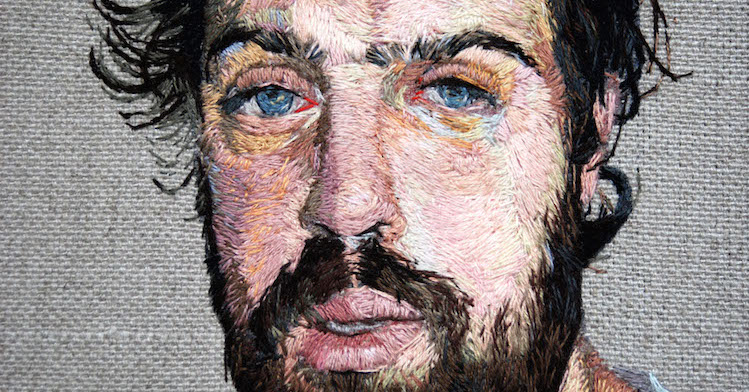
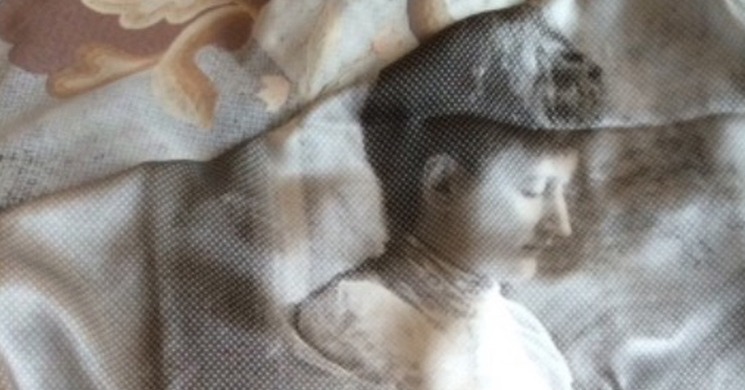
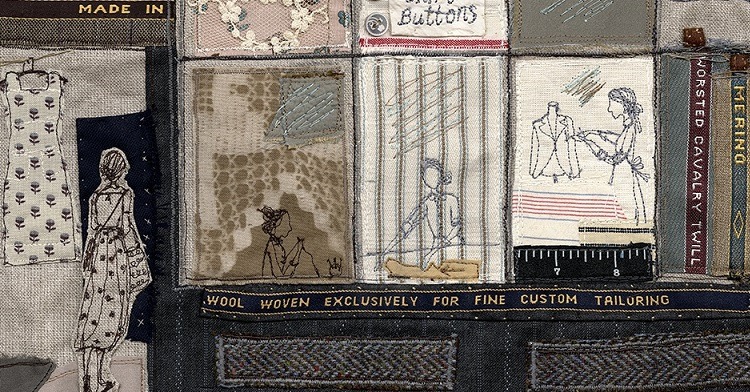
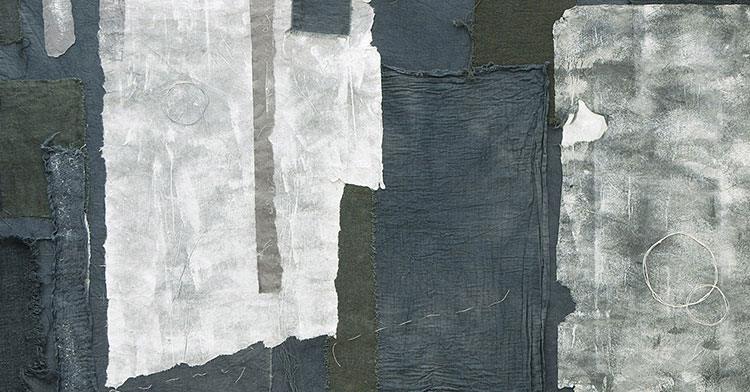
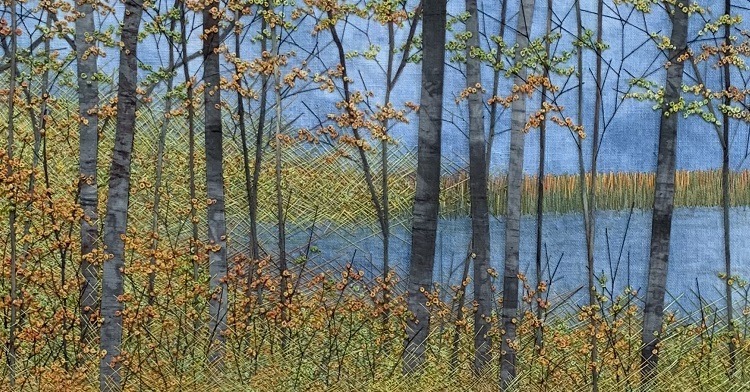
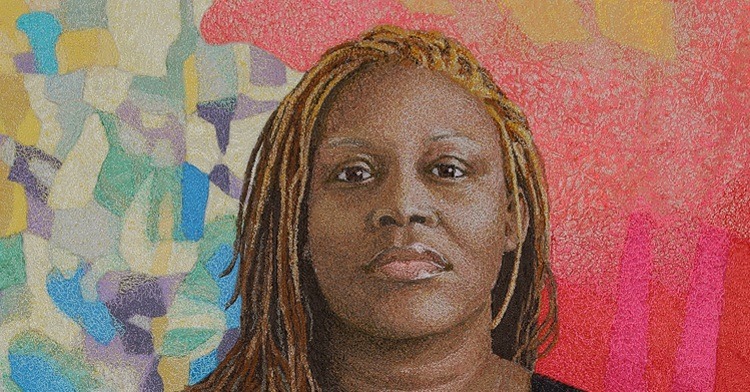
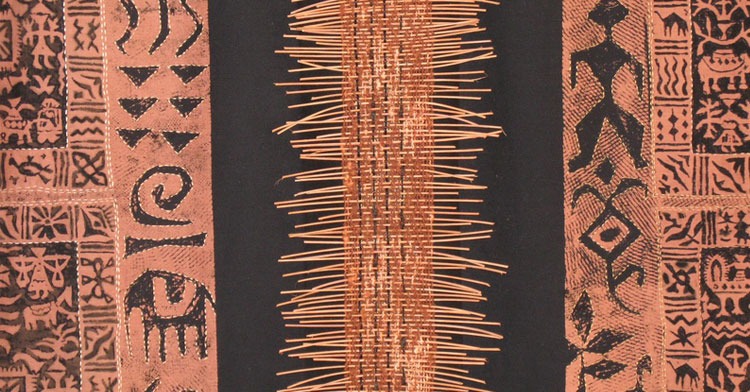
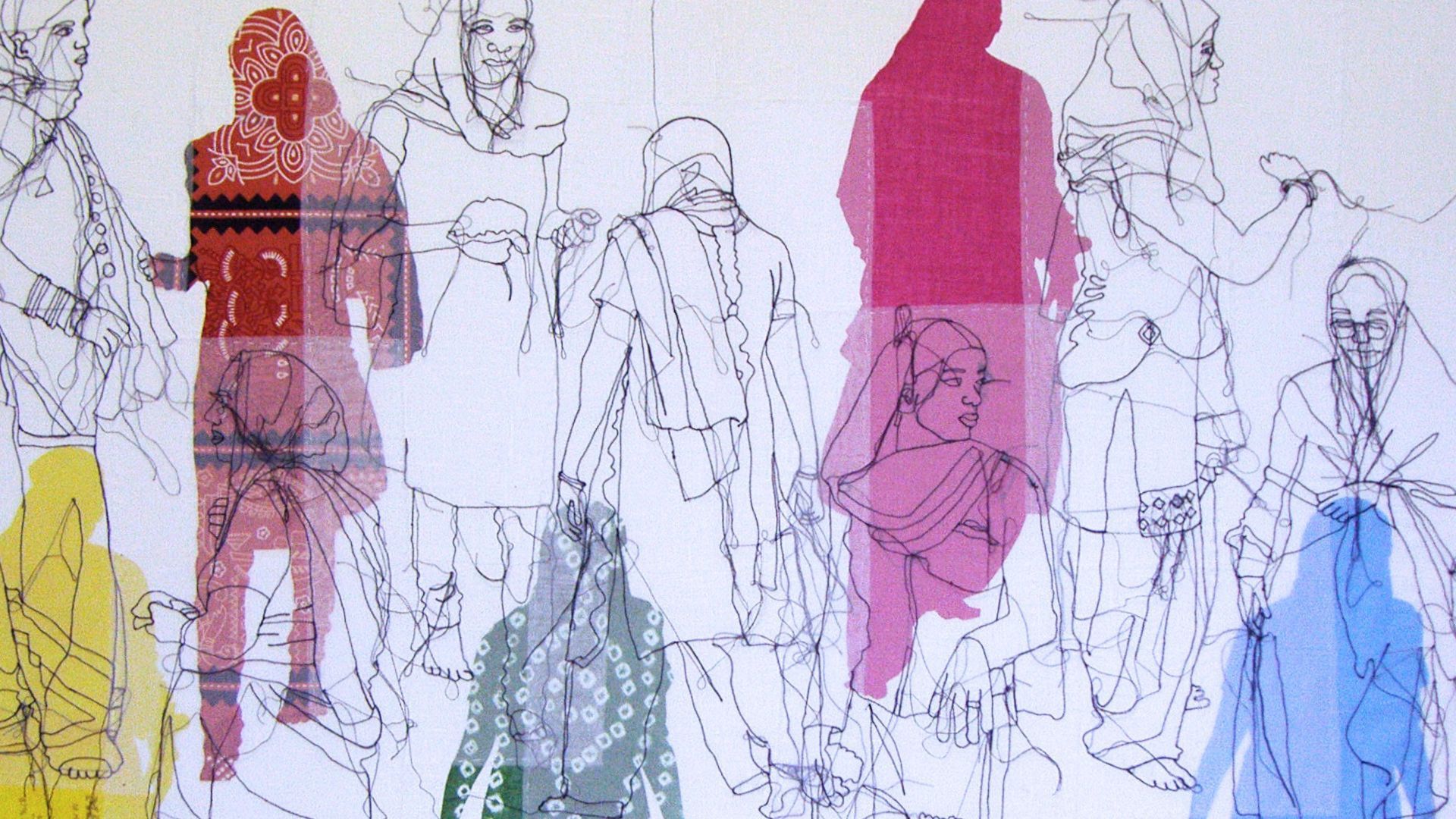
![Contemporary textile artist Lisa Solomon|Lisa Solomon - Sanjusangendo crowns [gold] - detail](https://www.textileartist.org/wp-content/uploads/Lisa1.jpg)
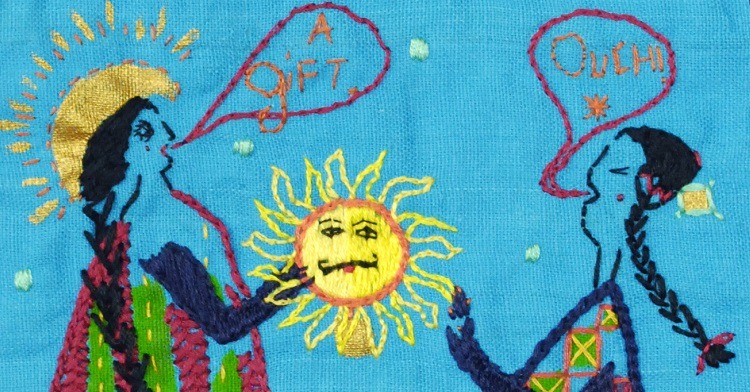
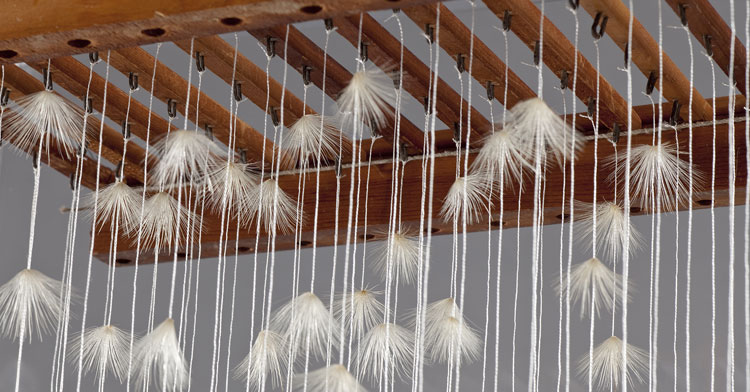
9 comments
Kathy Garvey
Excellent interview and wonderful work!
Amanda
Stunning work and an amazingly inspiring interview. I have stitched portraits by machine and hand for many years but have wandered off to explore other work practices but reading this article I now feel I want to return to what I now realise is my true love, than you.
K Wayne Thornley
Always happy to see coverage of men in fiber arts. He is awesome.
Daniel
We agree!
Gisèle
I am simply blown away! AMAZING work and creativity.I wish I lived closer I would enrol in your classes. I hope your students appreciate how fortunate they are they have you as a teacher.
Kimberly
While living in China, I was fascinated by the intricate embroidered portraits done by Chinese textile artists. Wondering if you were ever exposed to them and, if so, influenced.
Gloria Lowe
Amazing stitching just like painting with threads,love them.
Teresa Soares
Awesome works, made with a lot of artistry.
sharron wilcock
Thank you for this. I found the the art references interesting and the stitching amazing.